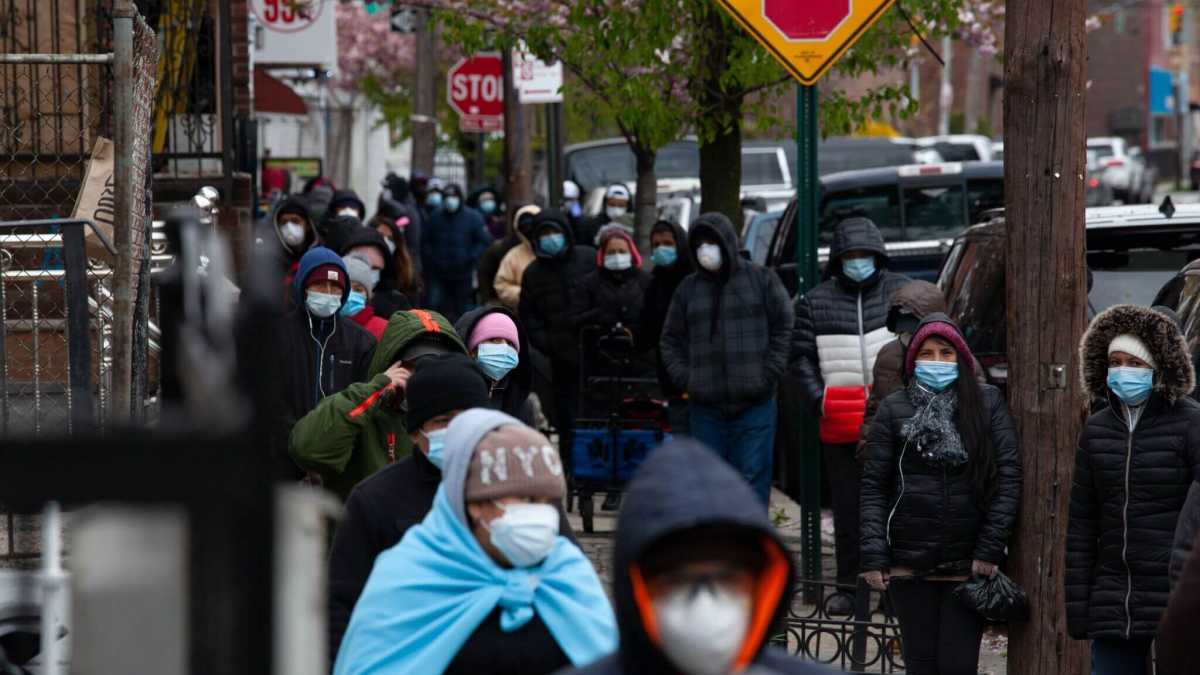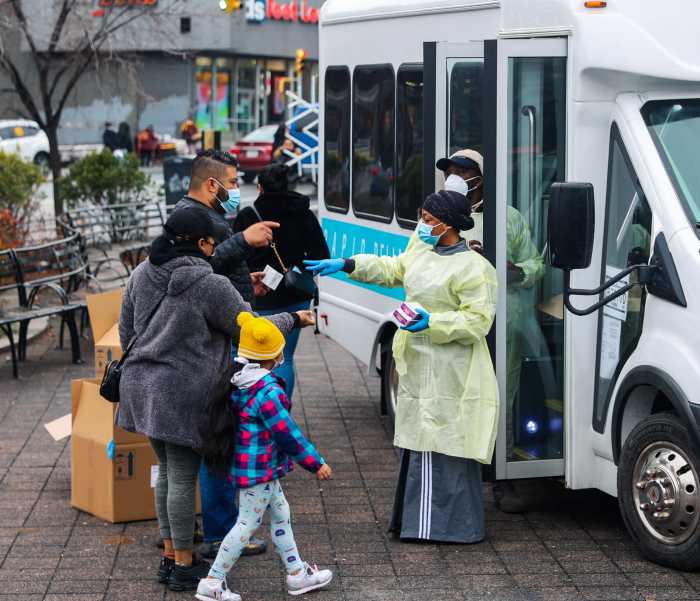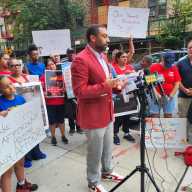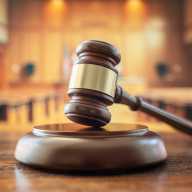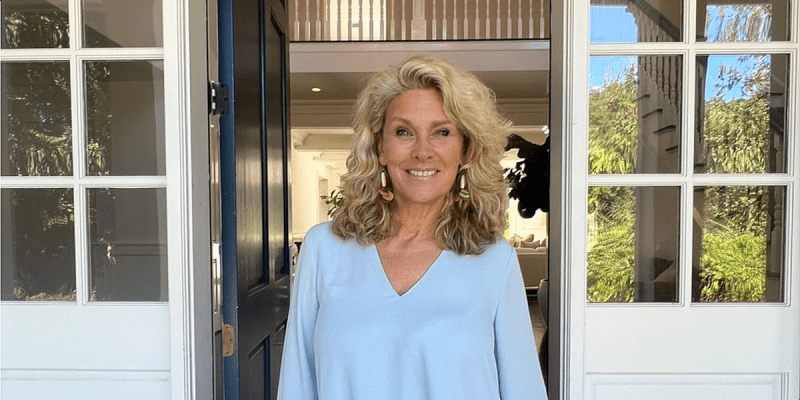“This story was originally published on Nov. 28 by THE CITY. Sign up here to get the latest stories from THE CITY delivered to you each morning.”
This story is part of MISSING THEM, THE CITY’s COVID-19 memorial and journalism project. MISSING THEM wants to understand the pandemic’s collective impact on New Yorkers. Did you experience long-term health problems after getting sick with COVID? Share your experience with us here. We’d also like to hear from those of you who are caring for people with long COVID including family members, caregivers and medical professionals.
Latinos across the entire city and residents of The Bronx reported long COVID symptoms at disproportionately high rates last year, according to new data from the Department of Health and Mental Hygiene obtained by THE CITY.
In The Bronx — which has the highest COVID death rate in New York City — 28% of adults who had COVID said they had lingering symptoms, the highest percentage in the city. In Manhattan, 20% of adults who had COVID said they had lingering symptoms, the lowest percentage in the five boroughs.
Of Latino adults in New York City, 30% who had COVID reported at least one long COVID symptom, compared to 23% of all white adults who had COVID.
This data comes from the DOHMH’s 2021 New York City Community Health Survey, which has yet to be released.
The survey randomly selected around 10,000 adults in New York City and asked if they had experienced any long-lasting health effects following a COVID infection such as cough, shortness of breath, fatigue, brain fog, headaches, joint pain, gastrointestinal upset, blood clots and depression. This marked the first time the department had asked these questions in its annual community health survey.
Dr. Celia Quinn, the health department’s deputy commissioner for disease control, testified at a City Council hearing last month that the 2021 health survey suggests that “up to 30% of New York adults who have had COVID-19 may experience some form of long COVID.”
Women were 1.4 times more likely to report symptoms than men.
“This represents a major public health burden and threat,” said Dr. Denis Nash, an epidemiologist and the executive director of CUNY’s Institute for Implementation Science in Population Health. “Once someone recovers from the acute phase of their COVID infection, it doesn’t mean that they’re necessarily going to be back to normal in a short period of time. Many, many people are struggling.”
The survey, which relies on New Yorkers to self-report symptoms, may not capture the full picture. “We could potentially underestimate the burden of long COVID in some communities,” Nash said. “Those with better access to care might be more likely to endorse the link [to COVID].”
The high rates of long COVID in The Bronx confirm that “a lot of the risk factors for long COVID overlap with COVID, and they also overlap with socioeconomic disadvantage,” he added.
City to Track Long COVID
Since COVID-19 is a new virus, studies like this one “are important to expand our understanding of its impacts,” Quinn said in an email through a health department spokesperson. The city health department is working to establish a system to monitor the prevalence and severity of long COVID among New Yorkers over time, the spokesperson added.
Scientists can’t yet say conclusively what’s driving disparities in long COVID rates, though experts point to a few possible causes. Black, Latino and low-income New Yorkers are more likely to have Type 2 diabetes and HIV — conditions that research shows increase the likelihood of developing long COVID.
Women are more likely to experience autoimmune diseases, and scientists have observed a correlation between some of these conditions and long COVID. Women also tend to take on a higher share of household labor, which can inhibit adequate rest. Lack of rest, especially early on during illness, has been shown to exacerbate long COVID.
Transgender, bisexual and disabled people are also reporting higher rates of the condition, according to national data.
“Infectious diseases can be markers of inequity, marginalization, and discrimination,” said JD Davids, a New Yorker and longtime HIV and AIDS activist who co-founded The Network for Long COVID Justice. “I think it’s imperative that we look specifically in New York City to see what’s happening.”
Little Relief, Few Answers
Katrina Corbell, 44, caught COVID-19 in March 2020 as the city was shutting down. Each time she thought she might be on the mend, her shortness of breath, migraines, sinus pain and diarrhea returned in full force.

“I just kept getting worse and worse,” she said. “I couldn’t do anything. I couldn’t even stay awake.”
In the months that followed, Corbell, who lives in The Bronx, found little relief. She developed a racing heart rate and dizziness, while old health challenges reemerged. Corbell has a history of epilepsy. She had been without seizures for two years; suddenly, they were back.
Like many people with long COVID, Corbell found few answers from her doctors. Some were supportive, some dismissive — and all were puzzled. After almost three months of escalating symptoms, her primary-care physician identified high levels of D-dimer protein in her blood, which can indicate blood clotting. Her doctor urged her to stay calm, pack a bag, put out food for her cat and go to the ER.
There, she was treated for a pulmonary embolism, which occurs when blood clots block blood flow in an artery in the lung. Just a week prior, her pulmonologist had dismissed Corbell’s COVID concerns and failed to detect the clots.
Like Corbell, people with long COVID can experience a range of symptoms and related conditions. Both blood clots and neurological conditions like seizures are associated with long COVID. It’s estimated that half of people with long COVID meet the diagnostic criteria for myalgic encephalomyelitis, or chronic fatigue syndrome, a complex and debilitating condition.
New Yorkers can be screened for long COVID at two dozen private and public clinics across the city, including three city-run COVID-19 Centers of Excellence in The Bronx, Brooklyn, and Queens. To date, the centers have had more than 20,000 visits, according to testimony by NYC Test and Treat Executive Director Ted Long at the Council hearing last month.
The city also offers AfterCare, a phone line and webpage that directs New Yorkers with long COVID to local clinics and an online support group.
Searching for More Support
Yet health advocates say these services don’t go far enough. They point to a dearth of doctors who know how to identify and treat long COVID, as well as barriers patients face such as high costs and denied insurance claims.
At a City Council hearing in October, Mount Sinai’s director of rehabilitation, David Putrino, urged city leaders to develop policies to “guide and enforce standards of necessary care” for New Yorkers with long COVID.
AfterCare directs residents to Body Politic, a patient-led, largely volunteer-run support group.
“It’s like one of the city’s main forms of places where people get support, information, connection,” said Davids, of the Network for Long Covid Justice. On Nov. 1 the Body Politic team announced that the 13,000-person community, which houses a NYC-focused Slack channel, is at risk of dissolving in early 2023 without additional funding.
Advocates like Davids are also calling for city leaders to create a robust long COVID support system modeled after the city’s own HIV/AIDS Administration where those living with long COVID can be paired with a case worker to get help accessing benefits, housing and medical care.
Unable to Work
Corbell had two jobs lined up in the spring of 2020: one with the U.S. Census Bureau and another with the New York City Board of Elections. Both positions were put on hold with the arrival of the pandemic. That June, Corbell got a call to start working as the city reopened. But she was too unwell to accept either position. “I had turned them both down because I literally couldn’t get out of bed,” she said.
Across the U.S., around 3.5 to 4.5 million people are currently out of work due to long COVID, according to a recent data analysis by the Brookings Institution. Research published in The Lancet shows around 20% of people with long COVID are unable to work, and almost half coped by reducing working hours.
With no income, Corbell relied on unemployment benefits and federal stimulus funds to get by. “A nonprofit was able to provide me a gift card,” she said. “And that’s how I was able to buy my cat food.” After the benefits dried up, Corbell said she lived on $183 a month in cash assistance from the Human Resources Administration for more than a year. Then, in December 2021, Corbell’s application for Supplemental Security Income was granted.
Now, she is finishing up a New York Peer Specialist certification with the Academy of Peer Services to help New Yorkers struggling with mental health and substance use. And Corbell is back to regularly volunteering with her church. Yet she’s not fully recovered.
After a three-month-long wait, Corbell was admitted into NYU’s Post-COVID Care Program, and still attends regular appointments with neurology and pulmonology specialists. While some of the worst symptoms are gone, her stamina is limited.
“I still can’t do like the uphill, upstairs, upwards. And I remember before March of 2020, I could still handle, like, four flights of stairs.”
For the past two years, MISSING THEM has been documenting stories of New Yorkers who died of COVID. Now, the team is turning to understand the pandemic’s collective and ongoing impact on the city. If you’re a New Yorker with long COVID, we’d like to hear from you. What are your biggest challenges and unanswered questions? What advice do you have for fellow New Yorkers with long COVID? Let us know here.
MISSING THEM is supported in part by the Brown Institute for Media Innovation at Columbia Journalism School.
THE CITY is an independent, nonprofit news organization dedicated to hard-hitting reporting that serves the people of New York

